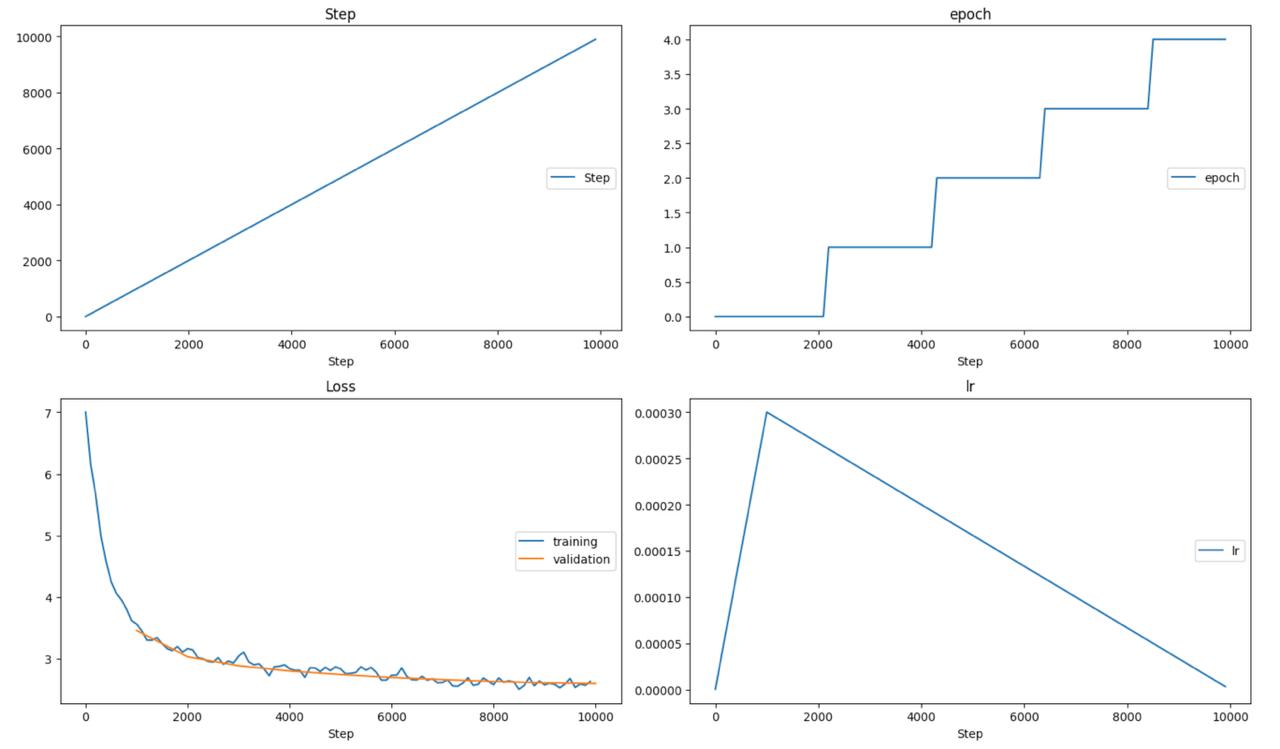1 · Project Summary
This project started as a course assignment whose goal was to build a complete small-scale language-model pipeline from scratch:
- Train a byte-level BPE tokenizer.
- Implement a Transformer-based causal LM.
- Train the LM on a corpus of Russian anecdotes.
All tasks are now complete; the repository history contains several model generations and ablation experiments.
2 · Model Variants
| preset | layers | heads | Kv-heads | hidden | FFN | max seq | extras |
|---|---|---|---|---|---|---|---|
| nano | 3 | 4 | 2 | 96 | 256 | 128 | – |
| mini | 6 | 6 | 3 | 384 | 1024 | 128 | – |
| small | 12 | 12 | 6 | 768 | 2048 | 128 | – |
Baseline architecture – ALiBi positional bias · Grouped-Query Attention · SwiGLU feed-forward.
| preset | layers | heads | Kv-heads | hidden | FFN | max seq | extras |
|---|---|---|---|---|---|---|---|
| nano-rope | 3 | 4 | 2 | 96 | 256 | 128 | RoPE ✓ · 16 latent tokens |
| mini-rope | 6 | 6 | 3 | 384 | 1024 | 128 | RoPE ✓ · 24 latent tokens |
| small-rope | 12 | 12 | 6 | 768 | 2048 | 128 | RoPE ✓ · 48 latent tokens |
Enhanced architecture – Rotary Positional Embedding + Multi-Head Latent Attention on top of the baseline.
3 · Training & Data
- Dataset: a cleaned collection of Russian jokes (IgorVolochay/russian_jokes).
- Optimizer: AdamW, linear warm-up, gradient-clipping 1.0.
- Loss: masked next-token cross-entropy, padding-aware.
(The full training scripts and notebooks will be published right after grading is finished.)
4 · Evaluation
| model | eval loss ↓ |
|---|---|
| base nano | 3.3025 |
| base mini | 2.6147 |
| rope + latent nano | 3.2494 |
| rope + latent mini | 2.5952 |
Lower is better. The rotary + latent tweak gives a consistent (though modest) improvement on both sizes.
5 · Repository Notes
- Each major experiment lives in its own commit tag.
- After course review, the complete training source will be pushed to the public branch.
6 · Quick peek at the model’s sense of humour
(exact raw samples taken from my own training run)
| prompt (ru) | continuation produced by the model |
|---|---|
Встречаются как-то → |
→ Встречаются как-то в Москве, один другому говорит: — Представляешь, на кого ты встретишься? |
Приходит мужик к врачу → |
→ Приходит мужик к врачу и видит, что у него болит голова. Врач его спрашивает: — А у меня есть палки? |
Сидит Вовочка на уроке → |
→ Сидит Вовочка на уроке, с мамой папе идёт к маме: — Сынок, ты в капусте, а ты — виски? — А ты козёл! Дай мне денег на розетку. |
Штирлиц подумал → |
→ Штирлиц подумал и говорит: «Теперь я буду дарить тебе макуляцию». |
Звонок в дверь → |
→ Звонок в дверь. Упал с работы. Она: — Всё! По-моему, мы с дружкой пропали. |
(top_k=10, max_new_tokens=200, eos_token_id=tokenizer.eos_token_id, do_sample=True)
7 · How to run the model
pip install transformers>=4.40 torch
import torch
REPO_NAME = "amocualg/llm-course-hw1"
device = torch.device("cuda" if torch.cuda.is_available() else "cpu")
tokenizer = ByteLevelBPETokenizer.from_pretrained(REPO_NAME)
check_model = TransformerForCausalLM.from_pretrained(REPO_NAME)
check_model = check_model.to(device)
check_model = check_model.eval()
text = "Штирлиц пришел домой" # change if needed
input_ids = torch.tensor(tokenizer.encode(text), device=device)
model_output = check_model.generate(
input_ids[None, :], max_new_tokens=200, eos_token_id=tokenizer.eos_token_id, do_sample=True, top_k=10
)
print(tokenizer.decode(model_output[0].tolist()))
ByteLevelBPETokenizer and TransformerForCausalLM will be available along with the source code
This model has been pushed to the Hub using the PytorchModelHubMixin
- Downloads last month
- 27
